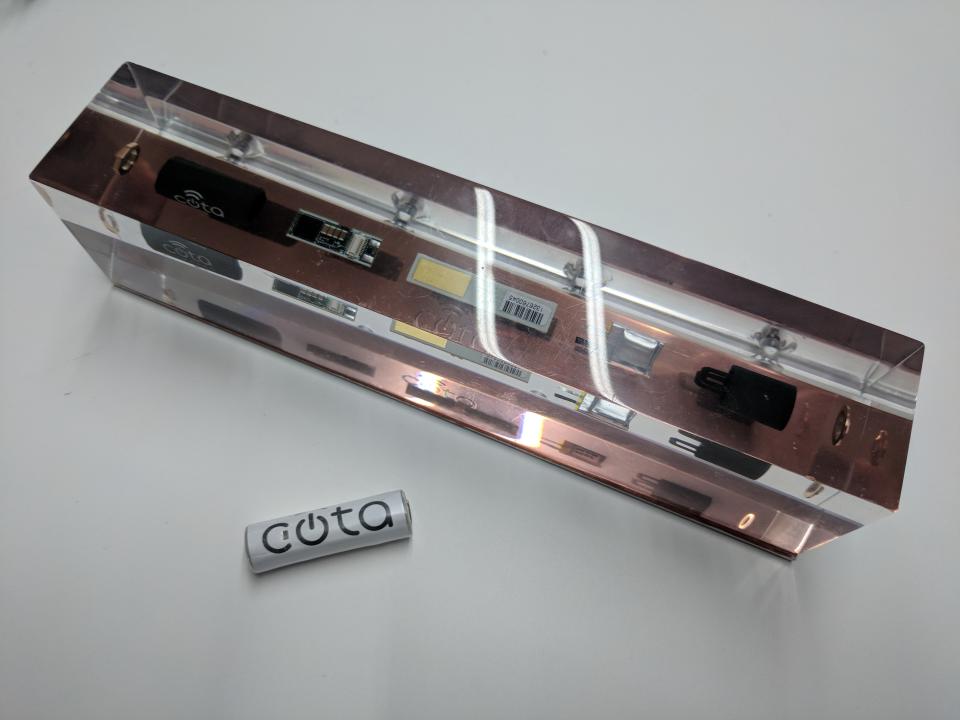These companies want to create truly wireless charging

Wireless charging like what’s in the iPhone 8 and iPhone X suffers from an embarrassing problem: It’s not truly wireless. There may be no plug involved, but the phone still must touch a charging surface that’s plugged into a wall.
(I’ve spent years calling this “cordless charging,” but the industry has yet to adopt my vocabulary.)
A handful of firms, though, are working to prove that true wireless charging is not just safe but can work. But as I saw from meeting with two such companies at Mobile World Congress in Barcelona last week, they face significant obstacles. Which means they probably won’t charge your phone through the air anytime soon.
Energous: underwear first
San Jose, California’s Energous (WATT) may be the first wireless-charging firm to have its technology in a consumer gadget. A “smart underwear” (no, really) firm called Skiin will include its wireless charging in its activity-tracking undergarments.
Energous vice president of marketing Gordon Bell explained that company’s WattUp receiver is much smaller than the coil-shaped receivers required by the Qi charging in Apple’s (AAPL) iPhone and other models, and doesn’t need an exposed metal surface. ”You can throw it in the wash if you want,” he said.
But the charger included with Skiin’s products will only employ Energous’s near-field charging, which in that implemtation will require direct contact. An upcoming hearing aid will also only include a near-field charger, although both sets of devices will work with future distance-charging gear.
Other partner firms will announce products this summer, Bell said. And while he didn’t name any, he said one is “big in smartphones.”
The company’s longer-range system — approved by the Federal Communications Commission in December, a move FCC chair Ajit Pai heralded in a tweet — can reach up to 15 feet by focusing its radio-frequency transmissions on compatible devices that it detects.
“The way that our distance chargers work, they seek out and see all the Bluetooth devices that are within Bluetooth range,” Bell said. That requirement, however, means that WattUp distance charging won’t work with a dead device. Instead, you’d need to use a near-field charger.
The rest of Energous’s vision involves thinking small, in part because of the inefficiency of its longer-range transmission — ”around 1%,” Bell said, which is way below the 65% or so that Qi can manage, which in turn falls below the 85% and higher efficiency requirements now applied to wired power adapters.
Update: After this story was posted, Energous said 1% is a worst-case figure, and that the company is seeing better rates in its latest hardware.
For example, he suggested that hotels would splurge for WattUp TV remote controls that would stay perpetually charged.
Ossia’s tile tactic
The other wireless-charging vendor to exhibit at MWC, Bellevue, Washington-based Ossia, showed off a more comprehensive solution: a tile you can include in a ceiling that embeds its Cota system.
The transmitter in it, CTO Hatem Zeine explained at the show, listens to radio-frequency signals from Cota-compatible devices and then targets a beam to them. It can power a phone from up to six feet away, even if you move the phone.

Like Bell, Zeine insisted that his system won’t heat or harm people. “We’ve solved the safety issue,” he said.
Ossia’s first customer, however, won’t use that tile. An Indian auto-components manufacturer named Motherson Sumi will build Cota into dashboard components to power other sensors in a car as well as driver’s gadgets — sometime in 2021.
In homes, Ossia hopes to see manufacturers include Cota in other devices, such as wireless routers, that would then distribute power to various smart-home gadgets.
Chief revenue officer Doug Stovall said Cota can transfer power at between 30% and 40% efficiency, adding that “We believe that will only get better over time.”
First, though, the company needs to secure its own FCC approval, which Stovall said he expects to see happen this year. It will also need more third-party support, which may be hindered by Ossia’s practice of charging companies to evaluate its technology.
What are the odds?
Something matching the obvious concept of wireless charging — one gizmo at home that beams power to a variety of devices — may come from a third company: Pittsburgh-based Powercast.
The firm has been around for longer than both Energous and Ossia — I first saw it demonstrate wireless charging at CES 2007 — and secured its own FCC approval in December. It says its targeted radio-frequency system can trickle-charge smart home sensors from up to 80 feet away but can’t power a phone, a more energy-intensive use, more than two feet distant.
It aims to ship its first consumer product, a $100 rectangular transmitter called the PowerSpot, in the third quarter of this year. Compatible gadgets will come later, starting with what a Powercast FAQ calls “two household names” that will deliver hardware either later this year or in early 2019.
In this fragmented market wireless-charging vendors should pick their use cases wisely.
Gartner analyst George Brocklehurst pointed to smart-home gadgets like Alphabet’s (GOOG, GOOGL) Nest cameras that already have customers willing to pay a premium. His advice to wireless-charging vendors: “Select the devices that are less sensitive to cost.”
Cheaper, simpler smart-home devices may instead wind up needing so little power that they can instead adopt “energy harvesting” — for instance, a tiny solar cell in a sensor attached to a window to detect break-in attempts, or a radiator sensor that converts ambient heat to electricity.
Meanwhile, phone battery life continues to get a little better and wired charging keeps getting faster. The biggest competition to wireless charging is customer inertia — or as Ossia’s Stovall put it, people “doing nothing” and sticking with old charging habits.
Email Rob at rob@robpegoraro.com; follow him on Twitter at @robpegoraro.

 Yahoo Finance
Yahoo Finance 
